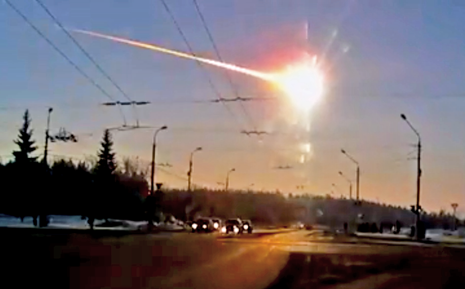A meteor with estimated mass of 10,000 tons by NASA (on entry to Earth’s atmosphere) exploded Friday morning over Russia’s Ural region and its shock-wave caused injuries to over 1,000 people. It took out windows and walls in the city of Chelyabinsk.
Some years ago, I personally witnessed a much smaller fireball, and I was convinced I was seeing an airplane crash.
On the same day, Friday 15th February 2013, skimming closer to the earth than any other asteroid of its size, Asteroid 2012 DA14 missed us by 17,100 miles, a margin closer than some satellites.
Experts had given assurances there was nothing to fear from the asteroid, which was too small to see with the naked eye even at its closest approach over the Indian Ocean, near Sumatra.
At 50 metres across (about the size of an Olympic swimming pool), the object was a relative tiddler in comparison with the one said to have measured 5 miles across that wiped out the dinosaurs 65 million years ago.
Nevertheless, an impact would have resulted in immense damage given the asteroids 143,000-ton mass, releasing the energy equivalent of 2.4 million tons of TNT and wiping out 750 square miles (1,942 square kilometres).
In a rather uncomfortable coincidence, a measure of the type of damage that can result from such rocks from space was demonstrated earlier on Friday when a meteor streaked across the sky and exploded over central Russia, raining fireballs over a vast area and causing a shock-wave, or sonic boom, that smashed windows, damaged buildings and injured 1,200 people.
“We can find these objects, we can track their motions, and we can predict their orbits many years into the future,” noted Robert Naeye of Sky and Telescope in an essay called, “Lessons from the Russian Meteor Blast.”
“And in the unlikely event that we actually find a dangerous object on a collision course with Earth, we might actually be able to deflect it if given sufficient warning time. Now, every government in the world is keenly aware of the possibility of meteor explosions over its territory.”
The Russian parliament is also keen on the idea. “Instead of fighting on Earth, people should be creating a joint system of asteroid defence,” Affairs Committee chief Alexei Pushkov wrote on his Twitter account late Friday. Russian Deputy Prime Minister Dmitry Rogozin on Saturday reiterated the idea and proposed a global defence system to counter space threats.
And on CNN, Lawrence Krauss, professor of physics, talked about how human technology has advanced to the point of predicting and, more interestingly, deflecting oncoming meteorites that could cause the earth “significant damage.”
“We have to think about it seriously”, he said. “It’s not science fiction. We can send a rocket out and land on [a meteor] or impact with it.” If the meteor is far enough, “A small rocket running for a while [can cause] a small angular change, enough to have it miss the earth.”
Meanwhile a new program called ‘Advanced Terrestrial-Impact Last Alert System’( ATLAS) is about to be launched. According to The Guardian “The University of Hawaii has proposed a cheaper, simpler system known as Atlas, to be constructed with the help of a $5 million grant from NASA.” Its aim is to create a warning system on oncoming asteroids and find ways to save earth from the impact.
That man has changed the planet is now well-accepted. Long before the industrial revolution and the age of climate change, humans have significantly impacted earth, at least according to climate scientist William Ruddiman. In his book titled “Plows, Plagues, and Petroleum How Humans Took Control of Climate“, he claimed that there is significant evidence that levels of carbon dioxide in the atmosphere have been rising since the earliest beginnings of agriculture.
Unlike our ancestors, however, increasingly we are aware that human actions have an impact on the entire planet and beyond.
The knowledge informs NASA’s decision in September 2003 to crash the spacecraft Galileo on Jupiter rather on Europa, one of Jupiter’s 39 satellites. Europa has an ocean under its ice and active volcanoes to boot. It just might be supporting alien life. Jupiter, on the other hand, is very hot and gaseous and deemed incapable of life. Crashing Galileo on Europa would have risked contaminating it with microbes from earth.
In fact, we have been interacting with the heavens longer than most have thought. Think of it in term of radio waves. According to Adam Grossman, “Mankind has been broadcasting radio waves into deep space for about a hundred years now … That, of course, means there is an ever-expanding bubble announcing humanity’s presence to anyone listening in the Milky Way. This bubble is astronomically large (literally), and currently spans approximately 200 light years across.”
Or think of it in term of our orbiting trash. According to NASA, “More than 500,000 pieces of debris, or “space junk,” are tracked as they orbit the Earth. They all travel at speeds up to 17,500 mph, fast enough for a relatively small piece of orbital debris to damage a satellite or a spacecraft. “
While some fall to earth, others exit into outer space. In other word, the cosmos might rain meteors on earth, but humans too have already interacted with the universe by sending man-made debris into space.
Thanks to:
Andrew Lam at www.huffingtonpost.com
Bill Quinn at www.guardian.co.uk
Image: Meteor in the Russian Sky/ The New Yorker
